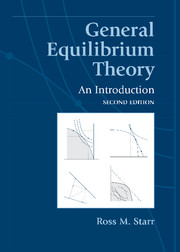Book contents
- Frontmatter
- Contents
- List of illustrations
- Introduction to the second edition
- Preface to the second edition
- Preface to the first edition
- Table of notation
- Table of assumptions
- A General equilibrium theory: Getting acquainted
- B Mathematics
- C An economy with bounded production technology and supply and demand functions
- D An economy with unbounded production technology and supply and demand functions
- E Welfare economics and the scope of markets
- F Bargaining and equilibrium: The core
- G An economy with supply and demand correspondences
- 23 Mathematics: Analysis of point-to-set mappings
- 24 General equilibrium of the market economy with an excess demand correspondence
- 25 U-shaped cost curves and concentrated preferences
- H Standing on the shoulders of giants
- Bibliography
- Index
24 - General equilibrium of the market economy with an excess demand correspondence
from G - An economy with supply and demand correspondences
Published online by Cambridge University Press: 05 June 2012
- Frontmatter
- Contents
- List of illustrations
- Introduction to the second edition
- Preface to the second edition
- Preface to the first edition
- Table of notation
- Table of assumptions
- A General equilibrium theory: Getting acquainted
- B Mathematics
- C An economy with bounded production technology and supply and demand functions
- D An economy with unbounded production technology and supply and demand functions
- E Welfare economics and the scope of markets
- F Bargaining and equilibrium: The core
- G An economy with supply and demand correspondences
- 23 Mathematics: Analysis of point-to-set mappings
- 24 General equilibrium of the market economy with an excess demand correspondence
- 25 U-shaped cost curves and concentrated preferences
- H Standing on the shoulders of giants
- Bibliography
- Index
Summary
General equilibrium with set-valued supply and demand
Our plan in this chapter is to take the model of production, consumption, the economy, and market equilibrium of Chapters 15–18 and restate it for the case of set-valued demand and supply behavior. Formally this means that we dispense with assumptions of strict convexity of tastes and production technology, C.VI(SC) and P.V. We rely rather on convexity, C.VI(C) and P.I. Under the remaining assumptions on consumption and production behavior, this will allow us to characterize demand and supply behavior as upper hemicontinuous, convex-valued correspondences. In turn, excess demand will then be characterized as upper hemicontinuous and convex-valued. A model of price adjustment that is also upper hemicontinuous and convex valued completes the picture: Applying the Kakutani Fixed-Point Theorem allows us to find a fixed point in price space that achieves a market equilibrium.
Just as we did in Chapters 15–18, we treat the economy in two formats: an artificially restricted bounded economy denoted by the superscript tilde notation (~) and an unrestricted economy (representing the true model we are really interested in). The artificially restricted economy is a purely technical construct, designed to allow us to develop the properties of the underlying unrestricted economy in a more tractable setting. The technique of the proof is to note that the restricted budget, demand, supply, and profit behavior is always well defined because it represents optimizing behavior on a compact set.
- Type
- Chapter
- Information
- General Equilibrium TheoryAn Introduction, pp. 293 - 311Publisher: Cambridge University PressPrint publication year: 2011



